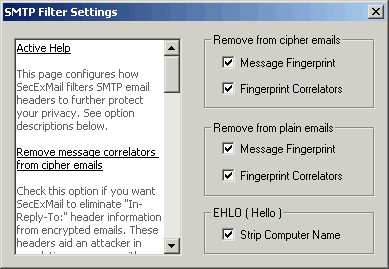- Introduction
- Configuration
- Keys
-
Email Clients
- Basic Email Client Configuration
- Outlook XP/2002
- Modifying Outlook XP/2002
- Outlook 98/2000/Express
- Modifying Outlook 98/2000/Express
- The BAT
- Modifying The BAT
- Pegasus
- Modifying Pegasus
- Eudora
- Modifying Eudora
- Calypso
- Modifying Calypso
- IncrediMail
- Modifying IncrediMail
- Netscape Mail
- Modifying Netscape Mail
- Technical
-
FAQ
- What email clients work with SecExMail ?
- Does SecExMail work with IMAP?
- How secure are SecexMail keys ?
- Is SecExMail legal in my country ?
- Does SecExMail support signatures ?
- Does SecExMail work with PGP ?
- Is the source code available for SecExMail ?
- Why can I not mix clear text and cipher recipients ?
- About
| Previous Top Next |
Email Encryption for Windows
Outgoing Mail Filter
This page configures how SecExMail filters SMTP email headers to further protect your privacy.

Every email message bears a unique fingerprint or message identifier which may be used to track the message across a network or indeed across the global internet. Further, each email reply contains a fingerprint correlator that allows the reply to be uniquely associated with the original message. SecExMail allows you to remove both message fingerprints as well as fingerprint correlators. Note that this will also disable message threading functionality in email client software.
Remove message fingerprint from cipher emails
Check this option if you want SecExMail to eliminate "Message-ID:" header information from encrypted emails. Modifying this setting will have immediate effect.
Shown below is an excerpt from a typical SMTP header containing a Message-ID fingerprint :
Return-Path: <yourname@offshoremailroom.com>
Delivered-To: john_doe@offshoremailroom.com
Received: from (HELO yourmachine_name) (yourname@203.134.3.41)
by localhost with SMTP; 23 Jul 2002 09:52:57 -0000
From: "Your Name" <yourname@offshoremailroom.com>
To: <john_doe@offshoremailroom.com>
Subject: Testing
Date: Tue, 23 Jul 2001 10:55:35 +0100
Message-ID: <000221c27717$gax278f1$0800a8c0@yourname>
MIME-Version: 1.0
The same header would appear as follows with the Remove message fingerprint option checked :
Return-Path: <yourname@offshoremailroom.com>
Delivered-To: john_doe@offshoremailroom.com
Received: from (HELO yourmachine_name) (yourname@203.134.3.41)
by localhost with SMTP; 23 Jul 2002 09:52:57 -0000
From: "Your Name" <yourname@offshoremailroom.com>
To: <john_doe@offshoremailroom.com>
Subject: Testing
Date: Tue, 23 Jul 2001 10:55:35 +0100
MIME-Version: 1.0
Remove fingerprint correlators from cipher emails
Check this option if you want SecExMail to eliminate "In-Reply-To:" header information from encrypted emails. Modifying this setting will have immediate effect.
Shown below is an excerpt from a typical SMTP header containing a fingerprint correlator :
Return-Path: <yourname@offshoremailroom.com>
Delivered-To: john_doe@offshoremailroom.com
Received: from (HELO yourmachine_name) (yourname@203.134.3.41)
by localhost with SMTP; 23 Jul 2002 09:52:57 -0000
From: "Your Name" <yourname@offshoremailroom.com>
To: <john_doe@offshoremailroom.com>
Subject: Testing
Date: Tue, 23 Jul 2001 10:55:35 +0100
Message-ID: <000221c27717$gax278f1$0800a8c0@yourname>
In-Reply-To: <000801c23789$3r040dc0$1441a8c0@nimitz>
MIME-Version: 1.0
The same header would appear as follows with the Remove fingerprint correlators option checked :
Return-Path: <yourname@offshoremailroom.com>
Delivered-To: john_doe@offshoremailroom.com
Received: from (HELO yourmachine_name) (yourname@203.134.3.41)
by localhost with SMTP; 23 Jul 2002 09:52:57 -0000
From: "Your Name" <yourname@offshoremailroom.com>
To: <john_doe@offshoremailroom.com>
Subject: Testing
Date: Tue, 23 Jul 2001 10:55:35 +0100
Message-ID: <000221c27717$gax278f1$0800a8c0@yourname>
MIME-Version: 1.0
Remove message fingerprint from plain emails
Check this option if you want SecExMail to eliminate "Message-ID:" header information from clear text emails. Modifying this setting will have immediate effect.
Remove fingerprint correlators from plain emails
Check this option if you want SecExMail to eliminate "In-Reply-To:" header information from clear text emails. Modifying this setting will have immediate effect.
Erase Computer Name from EHLO command
Email clients initiate the SMTP handshake with the EHLO command or "Hello" command. Usually the EHLO command will be used to identify your computer to the mail server. If you operate on a private network and behind a firewall the EHLO command will disclose your computer's true identity even if the firewall is used to mask your private IP address. This can be useful information to a hacker in locating sensitive information on a corporate network should firewall security ever be compromised. Check "Erase Computer Name" if you want SecExMail to erase your computer's identity from the EHLO command. Modifying this setting will have immediate effect.
Shown below is an excerpt from a typical SMTP header containing EHLO computer identity information :
Return-Path: <yourname@offshoremailroom.com>
Delivered-To: john_doe@offshoremailroom.com
Received: from (HELO yourmachine_name) (yourname@203.134.3.41)
by localhost with SMTP; 23 Jul 2002 09:52:57 -0000
Date: Tue, 23 Jul 2001 10:55:35 +0100
The same header would appear as follows with the Erase Computer Name option checked :
Return-Path: <yourname@offshoremailroom.com>
Delivered-To: john_doe@offshoremailroom.com
Received: from (HELO ) (yourname@203.134.3.41)
by localhost with SMTP; 23 Jul 2002 09:52:57 -0000
Date: Tue, 23 Jul 2001 10:55:35 +0100
The exact message layout depends on your mail server and email client software.
The SMTP protocol uses the HELO command. EHLO is used by the Extended Simple Mail Protocol ( ESMTP ).